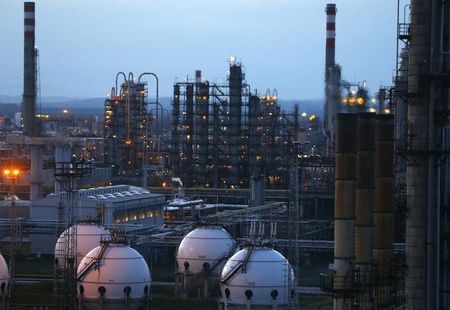Commodities
Oil prices retreat; remain elevated on demand hopes, geopolitical tensions

Investing.com–Oil prices retreated Tuesday, handing back some of the hefty gains seen over the last few days on optimism of an increase in demand during the summer season.
At 08:25 ET (12:25 GMT), fell 0.5% to $84.77 a barrel, while dropped 0.5% to $81.20 a barrel.
Markets bet on summer demand boom
Traders appear to be banking some profits Tuesday, with prices close to their highest levels since early-May.
Oil prices have advanced in recent sessions, underpinned by expectations that demand will improve as travel picks up pace during the summer season.
This notion was furthered by recent data showing an unexpected draw in U.S. inventories, with gasoline stockpiles declining.
This afternoon sees the latest U.S. inventories data, with the industry body releasing its latest forecasts.
oil stockpiles are expected to have fallen by 3 million barrels in the week to June 21, a preliminary Reuters poll showed on Monday. Gasoline stocks were also expected to have declined while distillate inventories are likely to have risen.
Israel-Hamas, Russia-Ukraine tensions in play
Persistent geopolitical disruptions in the Middle East and Russia also kept concerns over potential supply disruptions in play.
Israel kept up its pace of air strikes on Gaza, while also pushing further with its ground assault on Rafah. A ceasefire with Hamas appeared to be a distant prospect, while reports of a potential escalation in the conflict into an all-out war with Hezbollah also came into play.
In Russia, Ukraine said it had damaged more than 30 Russian oil refineries, as Kyiv continued to target Russia’s key oil producing infrastructure.
Fed worries remain
However, concerns about the strength of the US. economy, the largest consumer of oil in the world, remain, especially as it grapples with high interest rates and sticky inflation.
The focus this week is on key data, which is the Federal Reserve’s preferred inflation gauge, for more cues of the potential of interest rate cuts later this year.
Outside the U.S., deteriorating economic conditions in Europe pointed to dwindling demand in the region.
Doubts over an economic recovery in China also remained in play, as traders awaited more stimulus measures in the world’s biggest oil importer.
(Ambar Warrick contributed to this article.)
Commodities
Oil prices rise; U.S. crude inventories plunge, Russia-Ukraine truce eyed
Commodities
India’s Reliance to stop buying Venezuelan oil over US tariffs, sources say
Commodities
Oil prices climb on Venezuela supply worries

 Forex3 years ago
Forex3 years agoForex Today: the dollar is gaining strength amid gloomy sentiment at the start of the Fed’s week

 Forex3 years ago
Forex3 years agoUnbiased review of Pocket Option broker

 Forex3 years ago
Forex3 years agoDollar to pound sterling exchange rate today: Pound plummeted to its lowest since 1985

 Forex3 years ago
Forex3 years agoHow is the Australian dollar doing today?

 Cryptocurrency3 years ago
Cryptocurrency3 years agoWhat happened in the crypto market – current events today

 World3 years ago
World3 years agoWhy are modern video games an art form?

 Commodities3 years ago
Commodities3 years agoCopper continues to fall in price on expectations of lower demand in China

 Economy3 years ago
Economy3 years agoCrude oil tankers double in price due to EU anti-Russian sanctions























